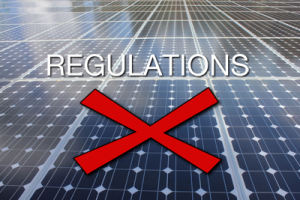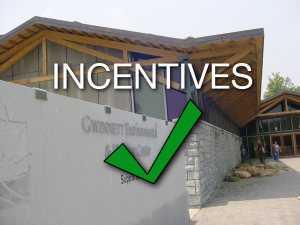Dayne Batten is a Research Assistant for the EFC and second year MPA student at UNC-Chapel Hill’s School of Government.

Alternative energy facilities, green site design features, and green building techniques (such as those required for LEED certification) are a promising way for citizens, businesses, and governments to minimize the environmental impacts of construction projects. Seizing on these opportunities for environmental responsibility, many local governments have provided incentive programs for green construction in their zoning ordinances. Other governments, seeking to walk a fine line between environmental friendliness and aesthetics, have regulated various features of alternative energy installations. But how many local governments are doing this? And what, specifically, are they doing?
Over the past year, I had the opportunity to work with David Owens at the UNC School of Government to survey North Carolina’s counties and municipalities about their zoning and land use regulations. Two-hundred ninety-six local governments (54% of those with zoning ordinances) responded to our survey, giving us a good picture of practices in communities around the state. Though the survey covered several diverse issues, it delved into several interesting questions about incentives and regulations for environmentally friendly facilities. I’ll talk about those specific financial incentives used by local governments and discuss two questions posed by the survey here.
Survey Results
First, we asked respondents whether their planning departments incentivized green site design, green building features, or alternative energy facilities. Twenty-six governments (about 9%) reported incentive programs of some type. Of those 26, 19 provided incentives for green site design features, 13 for green building features, and 8 for alternative energy facilities.
But just what are the common types of incentives included, and how do they positively impact developers financially?:
• Reductions or waivers for permitting fees: The average cost of a building permit across all North Carolina counties and municipalities responding to our survey was $428, though the cost was significantly higher in certain jurisdictions. Special or conditional use permits average over $2000 in NC municipalities with 25,000 or more people. Moreover, preliminary approvals for housing developments can reach well into the tens of thousands of dollars, depending on the size of the development. Though we did not ask specifically about which of these fees are waived or reduced as part of the incentive programs, it is clear that reducing or waiving these fees could provide a significant financial incentive for builders and developers to make green building choices.
• Expedited permit processing: The processing time for various approvals associated with the zoning and building process can stretch from an average of five to ten days for a building permit to an average of nearly two months for a special or conditional use permit. In many jurisdictions, the wait times can be significantly longer. By expediting these processes, counties and municipalities can allow builders to get moving on projects more quickly.
• Density bonuses: Many jurisdictions set zoning requirements for the maximum number of housing units per acre. In situations where the developer believes it would be more profitable to build a more dense neighborhood, granting a density bonus for inclusion of environmentally friendly practices can provide the developer with significant financial incentive to choose green practices.
• Height bonuses: Height bonuses are very similar to density bonuses, but instead apply to the allowable height of structures.
We also asked local governments about whether their zoning ordinances included any regulations on alternative energy facilities (including residential and commercial wind and solar installations). Forty-four governments (15%) reported having at least some type of regulations on alternative energy facilities.
 The most common regulations included:
The most common regulations included:
• Setback requirements
• Limits on size or height of installation
• Allowing commercial facilities only within particular zones, or only with a special use permit
• Screening requirements to limit visibility from adjacent property or roads
• Noise regulations for wind turbines
• Outright bans on wind turbines
With the exception of jurisdictions that banned wind turbines, many of these regulations may represent interest in alternative energy just as much if not more than opposition to it. Boards and councils that take the time to integrate alternative energy into their zoning plans may be the very ones that are hoping to see those types of facilities come to their communities. It is also worth noting that several local governments mentioned that they had specifically exempted alternative energy facilities from the standard screening requirements in their zoning ordinances.
It is very likely that, as alternative energy becomes a bigger part of the North Carolina economy, more local governments will be looking to incorporate environmentally friendly practices into their communities. Several years from now, these types of incentives and regulations may not be found in only 10 or 15% of North Carolina cities and counties, but in many governments across the state.
For More Information
For more information on the methodology used in our survey, or to find a list of jurisdictions that incentivize or regulate environmentally friendly initiatives, see the 2012 Zoning Survey Report – 2012 Zoning Survey Report – Zoning Adoption, Administration, and Provisions for Design Standards and Alternative Energy Facilities.
For further reading about green site design, consult the Sustainable Sites Initiative’s Guidelines and Performance Benchmarks.
For more information about sustainable building features and LEED certification, see the website of the U.S. Green Building Council.


